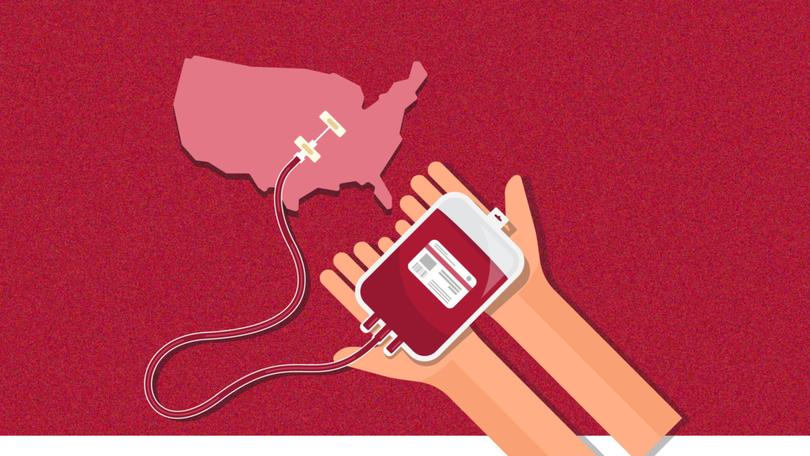The Economist: Blood money is a growing business in the US but it’s still not enough

An unusual sort of business will soon open in Shelby, North Carolina.
It will take over premises previously run by a flooring company, tucked in beside shops selling clothes, paint and fast food. But it will not sell anything itself. Instead, willing donors, paid around $US40 ($59) a pop, will sit connected to an apheresis machine.
Over the course of an hour, the machine will extract their blood, siphon out plasma and recirculate the remaining fluid. The plasma will then be made into medicines, such as clotting factors for haemophiliacs and intravenous immunoglobulins for those suffering from autoimmune diseases.
Sign up to The Nightly's newsletters.
Get the first look at the digital newspaper, curated daily stories and breaking headlines delivered to your inbox.
By continuing you agree to our Terms and Privacy Policy.Shelby’s latest arrival will be one of 400 or so plasma-collection centres to have opened in America since the start of 2020, as pharmaceutical firms respond to growing demand.
Last year American blood-product exports accounted for 1.8% of the country’s total goods exports, up from just 0.5 per cent a decade ago—and were worth $US37 billion ($54b). That makes blood the country’s ninth-largest goods export, ahead of coal and gold. All told, America now supplies 70 per cent or so of the plasma used to make medicine.
America’s booming blood trade is not an unmitigated success story, however, since it reflects problems elsewhere. The trade is mostly driven by two factors. The first is greater demand for plasma products: doctors have found ever more uses for the medicines, especially intravenous immunoglobulin.
According to Marketing Research Bureau, a data firm, the market for immunoglobulin has grown by 5-7 per cent a year for the past quarter of a century.
The second reason is restrictions on plasma collection in other countries, owing to a combination of misplaced worries about safety and concerns about the morality of rewarding people for their bodily fluids.
It is, for instance, illegal to pay for plasma donation in Britain, although the National Health Service does offer gifts and acknowledgments when donors reach certain milestones. In June the European Parliament approved new regulations that allow compensation to be offered for donations, but ban it from being mentioned in advertising and cap payments to an amount proportionate to the value of time spent donating. Whereas Americans can donate 104 times a year, many Europeans are limited to less than 30 times.
Such qualms do not stop countries from importing American blood.
Britain and Canada are almost entirely dependent on the country’s plasma; Europe brings in lots, too. China, a great rival of America in other areas of trade, is also more than happy to take advantage of America’s supply. Some 43 per cent of Chinese imports of blood products now come from its geopolitical rival, up from just 14 per cent a decade ago, according to figures from the UN. Chinese policymakers ban imports of plasma—a legacy of an attempt to prevent the spread of HIV in the 1980s—with the exception of a single protein, known as albumin. That alone is driving the trade.
Some countries are even more flagrant in their double standards. France lobbied against the European Union’s recent regulatory changes, arguing that they risked making the human body a commodity, as is “already a reality in the United States”.
At the same time, the French government is the sole shareholder in a company that owns six plasma centres in America, which pay donors, with the fluid collected available for use in France.
Yet hypocrisy is far from the worst problem in the blood trade.
According the University of Western Australia’s Albert Farrugia and colleagues, consumption of plasma medicine would be greater still if more was available.
They find that outside America, Australia and Canada, use of immunoglobulin is lower than studies estimating demand suggest it ought to be, indicating that people who would benefit from treatment are missing out.
Poorer countries are priced out of the market altogether and use almost no plasma-derived medicines.
Meanwhile, suitable synthetic plasma alternatives are thought to be some way off. It can take hundreds of donations’ worth of plasma to treat a single patient suffering from an autoimmune condition for a year.
So until other countries get their act together—bleed, America, bleed.
